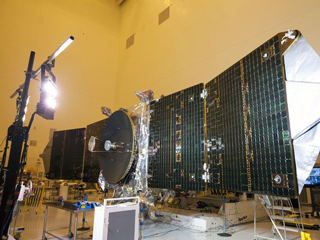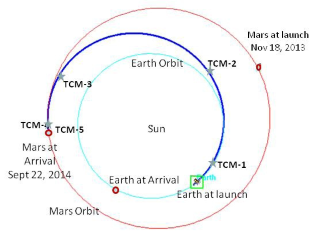MAVEN
TARGETS
QUICK LINKS

START DATE : 2013-11-13
The MAVEN mission launched on an Atlas V between November 18, 2013. Mars orbit insertion occured on September 22, 2014, after a ten-month ballistic cruise phase. Following a 5-week transition phase, the spacecraft entered Mars orbit at a 75 degree inclination, with a 4.5 hour period and periapsis altitude of 140-170 km (density corridor of 0.05-0.15 kg/km3). Over a one-Earth-year period, periapsis precessed over a wide range of latitude and local time, while MAVEN obtained detailed measurements of the upper atmosphere, ionosphere, planetary corona, solar wind, interplanetary/Mars magnetic fields, solar EUV and solar energetic particles, thus defining the interactions between the Sun and Mars. MAVEN explored down to the homopause during a series of five 5-day deep dip campaigns for which periapsis was lowered to an atmospheric density of 2 kg/km3 (~125 km altitude) in order to sample the transition from the collisional lower atmosphere to the collisionless upper atmosphere.
These five campaigns were interspersed though the mission to sample the subsolar region, the dawn and dusk terminators, the anti-solar region, and the north pole.
The MAVEN mission launched on an Atlas V between November 18, 2013. Mars orbit insertion occured on September 22, 2014, after a ten-month ballistic cruise phase. Following a 5-week transition phase, the spacecraft entered Mars orbit at a 75 degree inclination, with a 4.5 hour period and periapsis altitude of 140-170 km (density corridor of 0.05-0.15 kg/km3). Over a one-Earth-year period, periapsis precessed over a wide range of latitude and local time, while MAVEN obtained detailed measurements of the upper atmosphere, ionosphere, planetary corona, solar wind, interplanetary/Mars magnetic fields, solar EUV and solar energetic particles, thus defining the interactions between the Sun and Mars. MAVEN explored down to the homopause during a series of five 5-day deep dip campaigns for which periapsis was lowered to an atmospheric density of 2 kg/km3 (~125 km altitude) in order to sample the transition from the collisional lower atmosphere to the collisionless upper atmosphere.
These five campaigns were interspersed though the mission to sample the subsolar region, the dawn and dusk terminators, the anti-solar region, and the north pole.
The MAVEN mission launched on an Atlas V between November 18, 2013. Mars orbit insertion occured on September 22, 2014, after a ten-month ballistic cruise phase. Following a 5-week transition phase, the spacecraft entered Mars orbit at a 75 degree inclination, with a 4.5 hour period and periapsis altitude of 140-170 km (density corridor of 0.05-0.15 kg/km3). Over a one-Earth-year period, periapsis precessed over a wide range of latitude and local time, while MAVEN obtained detailed measurements of the upper atmosphere, ionosphere, planetary corona, solar wind, interplanetary/Mars magnetic fields, solar EUV and solar energetic particles, thus defining the interactions between the Sun and Mars. MAVEN explored down to the homopause during a series of five 5-day deep dip campaigns for which periapsis was lowered to an atmospheric density of 2 kg/km3 (~125 km altitude) in order to sample the transition from the collisional lower atmosphere to the collisionless upper atmosphere.
These five campaigns were interspersed though the mission to sample the subsolar region, the dawn and dusk terminators, the anti-solar region, and the north pole.
×
MAVEN
The MAVEN mission launched on an Atlas V between November 18, 2013. Mars orbit insertion occured on September 22, 2014, after a ten-month ballistic cruise phase. Following a 5-week transition phase, the spacecraft entered Mars orbit at a 75 degree inclination, with a 4.5 hour period and periapsis altitude of 140-170 km (density corridor of 0.05-0.15 kg/km3). Over a one-Earth-year period, periapsis precessed over a wide range of latitude and local time, while MAVEN obtained detailed measurements of the upper atmosphere, ionosphere, planetary corona, solar wind, interplanetary/Mars magnetic fields, solar EUV and solar energetic particles, thus defining the interactions between the Sun and Mars. MAVEN explored down to the homopause during a series of five 5-day deep dip campaigns for which periapsis was lowered to an atmospheric density of 2 kg/km3 (~125 km altitude) in order to sample the transition from the collisional lower atmosphere to the collisionless upper atmosphere.
These five campaigns were interspersed though the mission to sample the subsolar region, the dawn and dusk terminators, the anti-solar region, and the north pole.
The Planetary Plasma Interactions (PPI) Node of the Planetary Data System (PDS)
Available Data
 |
Privacy / Copyright Freedom of Information Act |
 |
Web Master: PDS-PPI Operator NASA Official: Becky McCauley-Rench |

